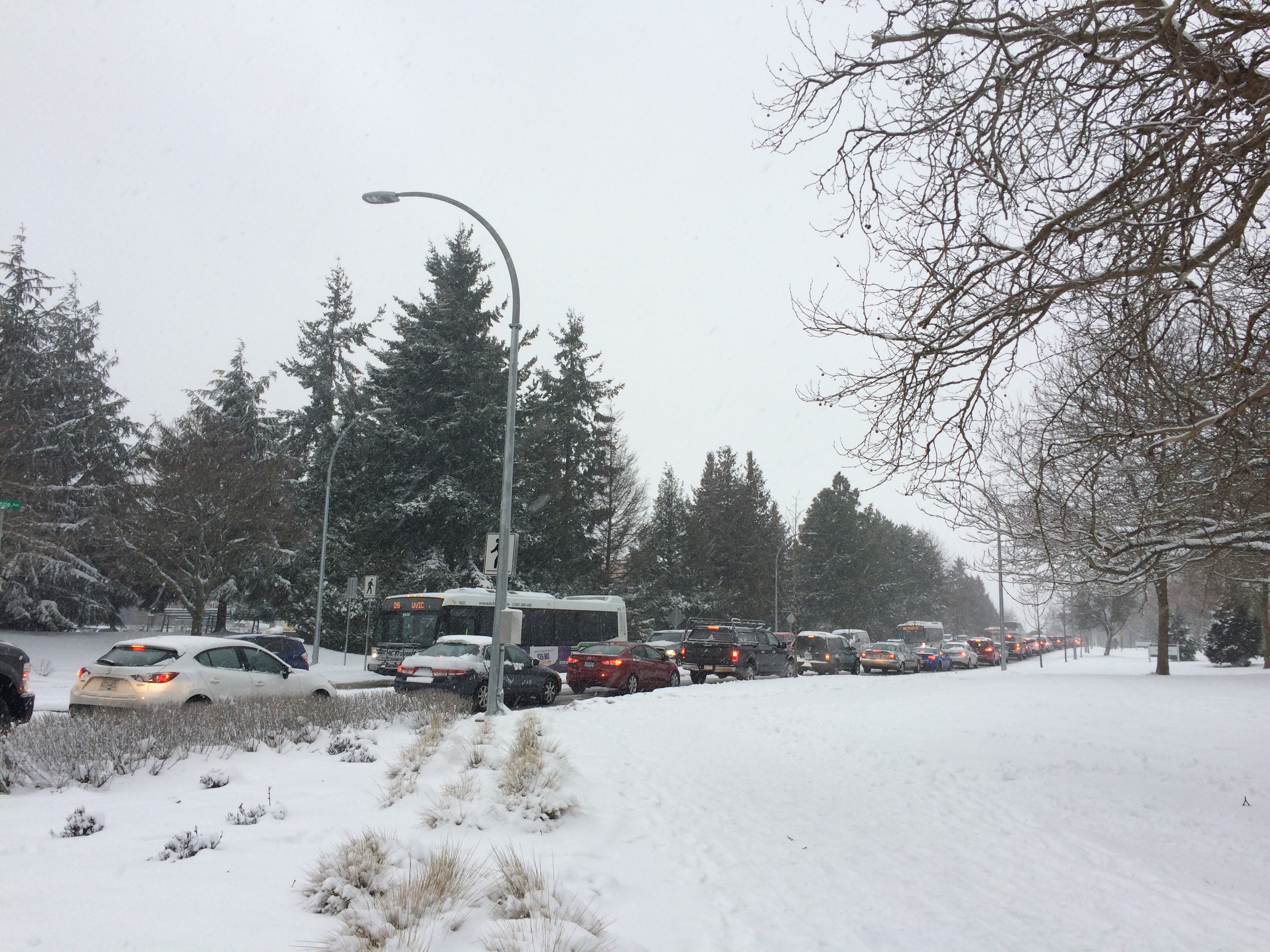
After Feb. 8’s snow melted, some wondered if UVic delayed too long in closing campus, and if giving more notice would’ve avoided traffic jams such as this one. File photo by Belle White, Photo Editor
For most students at UVic, Feb. 8’s snowstorm was the most chaos on campus they’d ever seen.
Cars were trapped in the flood of people trying to exit Ring Road, and hundreds of students waited in the snow and sleet for buses that took hours to arrive—if they showed up at all.
Along with the number of bruised knees, behinds, and egos, the weather also raised a few important questions, with the most prominent being whether UVic’s response to the snow could have been improved.
Robert Johns is the manager of emergency planning at UVic, and is in charge of preparing and guiding the campus through rare but threatening occurrences—things like earthquakes, gas leaks, or, perhaps the rarest of all, snow that sticks on the ground.
“My impression of Victoria as a whole,” says Johns, speaking from his office sat deep in the hallways of UVic Campus Security, “is that when snow happens it’s a bit of an event.”
The majority of his job entails leading emergency preparedness workshops and organizing the response systems in place at UVic. But on Tuesday, Feb. 7, Johns, like everyone on campus, was stuck dealing with the snowmageddon that descended on Victoria.
The heavy snowfall forced the closure of the university at 1:45 p.m. on Wednesday afternoon, disrupting thousands of people on campus and causing massive transportation jams as everyone headed home at the same time.
Camosun College also closed that day, announcing shortly after noon that it would close in two hours’ time. One reader who commented on our original report took the university to task for not giving similar notice.
“I had to quit work in the middle of the day to join the mad dash to wake up children and drag them home in the snow so UVic staff could go home,” they said. “Next time, UVic, at least an hour’s notice please. At least.”
So, did UVic in fact take too long to close campus?
“That’s a question that’s really difficult to answer,” Johns says.
The snow started early on Wednesday, building on what had already fallen the days prior, with flurries sweeping over grass, concrete, and any students unfortunate enough to be walking to class.
“From the time we got in at 7:30 in the morning here, through the day, we were continuously monitoring what was happening in the community. What’s the weather forecast, what are school districts doing, what are Camosun doing, what do the roads look like,” Johns says. “Then within that there’s always in the back of our minds, ‘what is the effect we have on campus and do we need to react in some way?’”
Much of the concern came with how much snow was actually sticking on the ground.
“In terms of the snow here it usually melts quite quickly,” Johns explains. As soon as they realized the snow was not dissipating, Johns says, UVic made the decision to close.
“In this case here, the decision is actually a consensus decision because it’s not an emergency. The snow last week was truly not an emergency,” he says. “There was a sense of urgency to make a decision, but it wasn’t like we had a gas leak or something else that would literally kill you right now.
“So that decision . . . was a combination of Campus Security and Facilities Management having conversations—plural—through the day, and finally making a recommendation . . . they sought consensus through up to the executive level of [UVic], validated that, and then the decision was made.”
At 1:45 pm, emergency notices were sent out—14 000 by text, 31 000 by email, others on various displays around campus—and students began to leave. But that only led to another issue: how to leave campus.
“It’s certainly not a grid pattern where you have multiple options,” Johns says. “If there’s a significant event on Ring Road, it does present some challenge in making sure that we get some traffic through and in a nice fashion.
“When we have the campus leaving all at the same time, the road system is going to be gridlocked. Whether there’s snow on the ground or not.”
Debriefings about the Feb. 8 closure had already begun at the time of our interview, and Johns acknowledged that both the timing of the closure and the traffic jams afterwards are areas worth looking at.
“There are things here that we’re looking at in terms of those two questions,” he says, “around campus closure and [the] release of everybody.”
It appears as though students will have to wait for any concrete solutions to the issues highlighted that day. But until the next snowstorm hits, Johns urges students to be prepared for any emergency eventuality on campus.
“Things happen, and it’s nice to be prepared,” he says. “What I’ve found in my life is that if we’ve got some basic preparedness, and bad things happen, it usually goes better because you’re prepared.”








